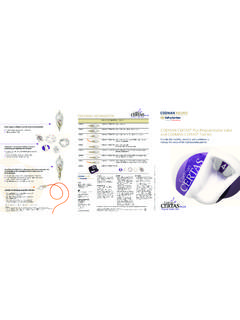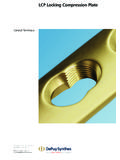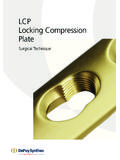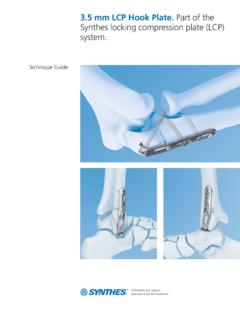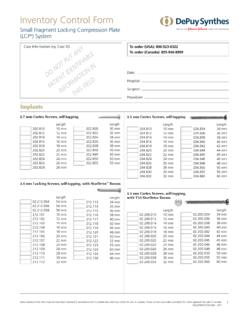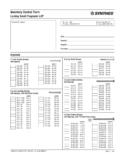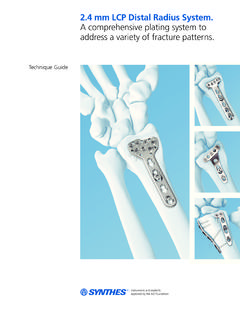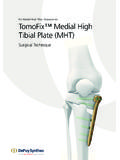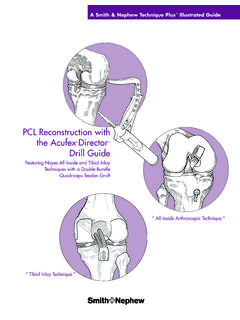Transcription of ATTUNE Knee System: Cruciate Sacrificing
1 ATTUNE knee system : Cruciate Sacrificing Fixed Bearing Christel Wagner knee Development Manager | DePuy Synthes Joint reconstruction INTRODUCTION: The purpose of a well functioning posterior Cruciate Sacrificing (CS) procedure in which the PCL is released ligament (PCL) in a native knee is to prevent the femur but is not replaced by a cam and spine. This procedure from translating too far anteriorly or the tibia from requires certain implant design considerations in order to translating too far posteriorly. The PCL also guides provide the resistance for translation that is typically posterior rollback of the femur. A surgeon who prefers to provided by either the PCL in a CR knee or the cam and retain the posterior Cruciate ligament (PCL) generally spine in a PS knee .
2 The ATTUNETM knee system CR fixed utilizes a Cruciate retaining (CR) component, while a bearing (FB) insert has been designed with the surgeon surgeon who excises the PCL generally utilizes a posterior who uses a CS procedure in mind, and it has been stabilized (PS) component, replacing the PCL with a cam cleared by the FDA for a CS application. and spine. A subset of surgeons utilize a Cruciate HISTORICAL REVIEW OF CS KNEES. One of the historical challenges of excising the PCL has been the effect on the flexion space and anterior- posterior (A/P) stability. Numerous studies have demonstrated that once the PCL is removed the flexion space can open up by several millimeters1, 2 and A/P. translation , 4. To address these challenges, two distinct design approaches were considered for CS applications.
3 The first approach was the development of a rotating platform (RP) device that incorporated a high degree of femoral to insert conformity. This device, called the Low Contact Figure 1. Stress knee (LCSTM knee system ), enabled size to size insert to femur matching. To achieve this conformity, a decoupling of rotational forces was built into the design by allowing flexion and extension to occur on the top side of the insert and internal and external rotation to occur on the backside (Figure 1). The system also incorporated gap balancing instruments to help balance the increased flexion space that occurred with an excised Figure 2. PCL. Literature has shown that this type of design was able to attenuate anteroposterior translation when the components, a different approach was taken from CS RP.
4 PCL was Knees. This new approach incorporated a uniquely designed polyethylene insert that featured a raised The second approach to CS applications was directed at anterior lip (Figure 2). This was first launched within the fixed bearing (FB) knees. Due to rotation and flexion Natural- knee system ,6 with the raised anterior lip acting occurring on the top side of the insert, and the articular as a ramp to provide subluxation resistance. surface accommodating several sizes of femoral 1. CURRENT DESIGN CHALLENGES WITH FIXED BEARING CS KNEES: Based upon the success of the FB Natural- knee . Ultracongruent insert, the industry began widely 21. adopting a raised anterior lipped polyethylene insert for CR. Joint component gap (mm). 19 PS. fixed bearing CS applications. Mid-term survivorship with these types of inserts has been However, to begin 17.
5 Addressing the 15- 20% of patients who are dissatisfied after TKA,7 it is important to understand the limitations 15. of these devices and how they may be improved. 13. The first limitation is associated with the raised anterior lip. In many cases the raised anterior lip does not 11. attenuate A/P sliding as compared to a standard CR. The anterior lip acts as a deterrent to subluxation. 9. 0 10 45 90 135. This is a result of compromises that have been accepted knee flexion angle ( ). into current FB constructs. In these FB constructs, the tibial tray and insert sizes match and the femur is allowed Figure 3: Graph showing the flexion space opening up to be upsized or downsized on top of the insert. As a in a PS knee versus a CR knee as the knee flexes result, FB CS inserts must be designed to accommodate articulation with a larger or smaller sized femur.
6 This creates a compromise in femoral to insert conformity. This compromise allows for the possibility of the femoral The last limitation is with regard to gap balancing. While component sliding forward rather than rolling back many companies in the industry have begun providing before it interacts with the anterior ramp of the CS femoral components with consistent A/P increments in polyethylene. DePuy Synthes Joint reconstruction testing between femoral sizes, there is still a need for inserts that has shown that the sliding distance of a femoral provide fine tune options for gap balancing. In many component on a raised anterior lipped insert, is similar to cases tibial inserts designed for a CS application have a standard CR This demonstrates that the anterior inconsistent increments between thicknesses.
7 Lip is not helping patients improve their stability throughout flexion but instead acting only as a barrier to To address these challenges in FB CS knees, the ATTUNE . subluxation. knee has focused on improving the following: The second limitation of current CS FB knees is related to Femoral to Insert Conformity the sagittal curvature of the femoral component. Data for Fixed Bearing CS Applications has shown there is relatively no difference in the extension gap when comparing knees with and without a Femoral Geometry for Fixed Bearing ,2 However, as the knee flexes to 45 degrees and 90 CS Applications degrees, the flexion gap increases significantly in PCL. deficient knees (Figure 3). When reviewing most current knee system Sizing and Balancing Features TKA designs, there is generally a significant, sudden for CS Surgeons reduction in the femoral radius of curvature between 30.
8 And 60 degrees. In some designs, such as Triathlon , this Subluxation Resistance transition occurs at 10 This sudden decrease in the femoral radius of curvature has the potential to increase the femoral component's ability to slide forward on the polyethylene during mid-flexion,9 especially in a PCL deficient knee where the flexion gap increases with deeper 2. ATTUNE CR FEMORAL TO INSERT CONFORMITY. FOR FIXED BEARING CS APPLICATIONS: To address limitations with an insert that can To demonstrate an increase in A/P stability with the accommodate several different femoral sizes, the ATTUNE ATTUNE CR versus a raised anterior lipped polyethylene system incorporates a patented fixed bearing central construct, a test was conducted to compare the ATTUNE . locking mechanism design that works across all sizes to CR insert to the SIGMA knee Curved Plus (CVD+) insert optimize patient fit and kinematics.
9 This design, the (Figure 4). The SIGMA CVD+ design features a higher LOGICLOCKTM Tibial Base, allows for the insert to always raised anterior lip than the ATTUNE CR insert design. The match the femoral component. In a FB CS application this testing that was performed assessed the amount of force enables increased sagittal conformity and stability. required to move the femoral component anteriorly and posteriorly on the tibial insert. As shown in the graphs below (Figure 5), the ATTUNE CR. insert provided similar or more resistance against anterior translation than the SIGMA CVD+ insert at different flexion This indicated a greater force is required to move the ATTUNE CR Femoral component anteriorly on the tibial insert. Figure 4: Depiction of in vitro A/P stability test CR Anterior Stability CR Anterior Stability 400 400.
10 350 350. 300 300. 250 250. A/P Face (N). A/P Face (N). 200 200. 150 150. 100 100. ATTUNE CR-FB ATTUNE CR-FB. 50 SIGMA CR-CVD+ 50 SIGMA CR-CVD+. 0 0. 0 2 4 6 8 10 12 0 2 4 6 8 10 12. A/P Translation (mm) A/P Translation (mm). Figure 5: A/P stability of CS fixed bearing designs ( ATTUNE CR and SIGMA CVD+) at 15 and 90 degrees of flexion. 3. ATTUNE FEMORAL GEOMETRY FOR FIXED BEARING CS APPLICATIONS: To address the limitations associated with a reduction in comparison to the SIGMA knee , NexGen and Triathlon . the femoral radius of curvature leading to instability,9 the (the conformity ratio is defined as the ratio of the femoral ATTUNE knee femoral components have incorporated a radius to the polyethylene insert radius). The data gradually reducing radius of curvature ( ATTUNE demonstrates higher stability with the ATTUNE CR.)
